Conduit 2025 State of Rollups: Trends, Data, and Predictions for the Rollup Landscape
Your comprehensive guide to the state of rollups in 2025: How they're scaling Ethereum, most popular choices for rollup tooling, predictions, and more.
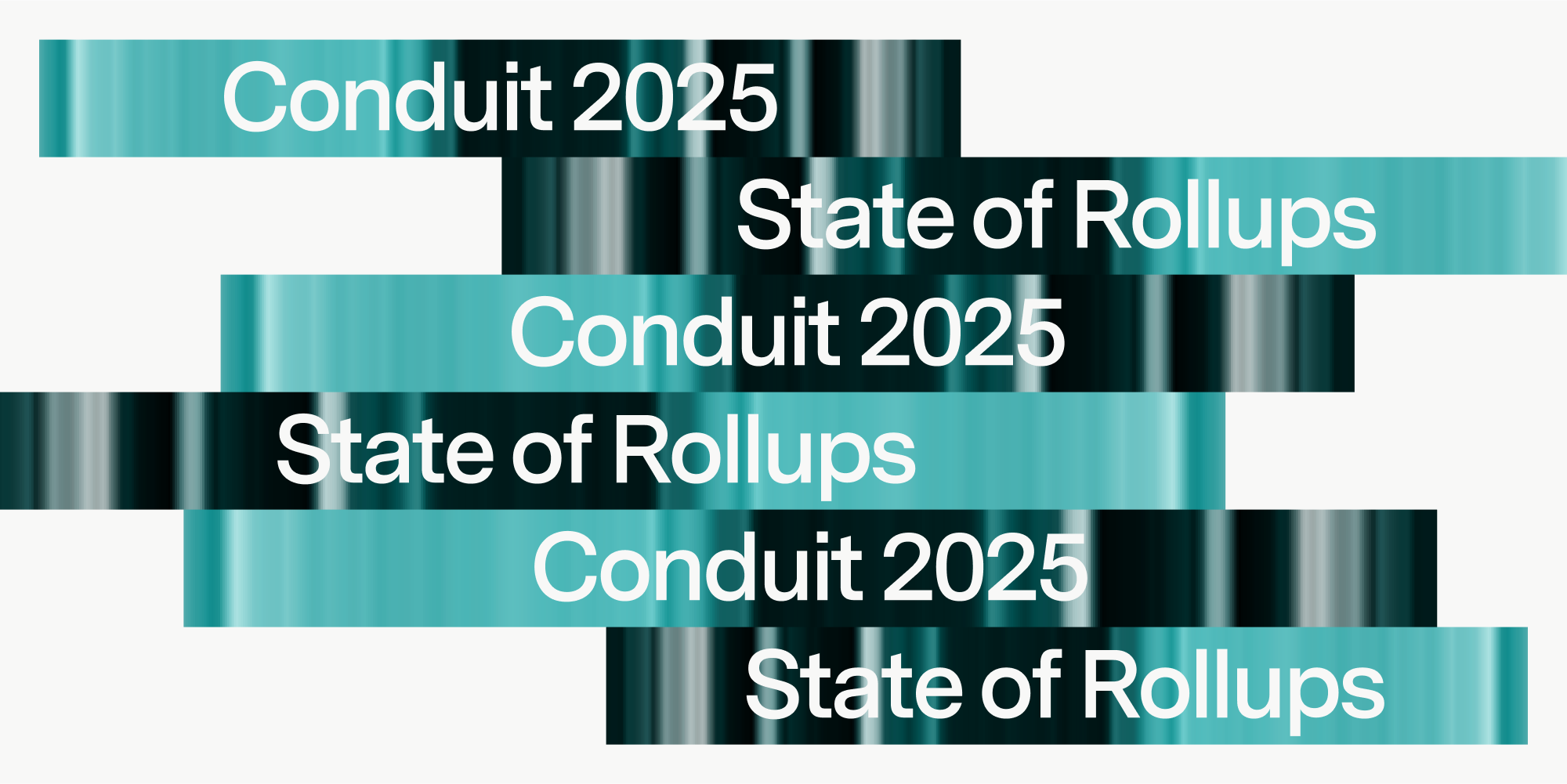
Table of contents:
Over the four years since the rollup-centric roadmap was first proposed, rollups have made enormous progress in scaling Ethereum. At any given time, rollups are scaling Ethereum’s computational power by 50-100x what’s possible on Ethereum mainnet alone.
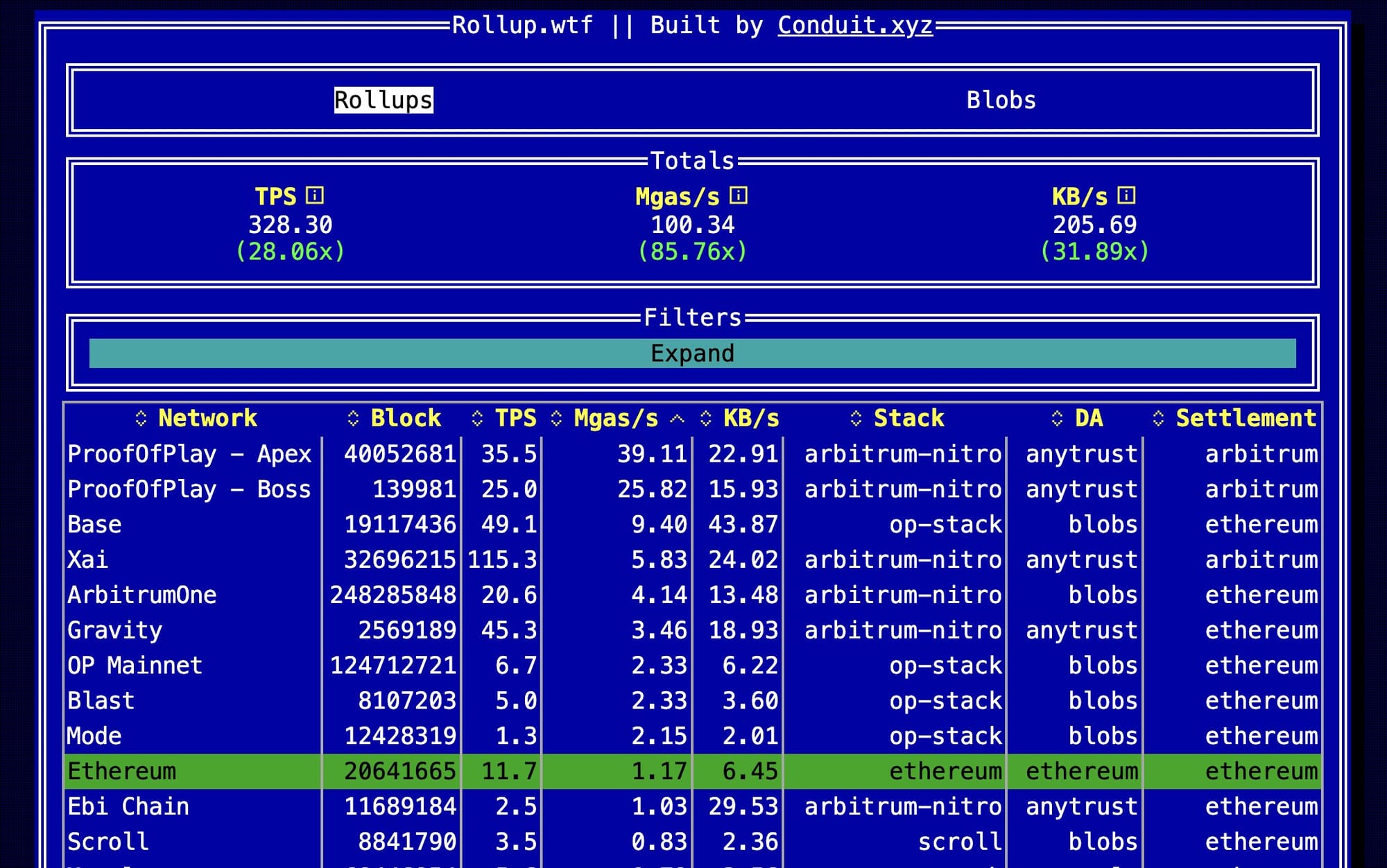
Rollup scaling is making Ethereum the world computer it’s intended to be, all while maintaining comparable security guarantees and censorship resistance of mainnet.
That scaling is enabling a network of unstoppable apps that move beyond the financial primitives that have scaled DeFi to this point. Rollup teams are building everything from games to social networks to onchain versions of web2 consumer apps. Most of these new apps wouldn’t be possible to run on Ethereum mainnet, either due to fees or simple lack of throughput.
Rollups have moved the horizon of what’s possible to build on Ethereum, and we’re still so early.
As the leading rollup platform, we’ve helped make many of these advancements happen. In this report, we want to share with you what we’re seeing in the world of rollups. Keep reading for a comprehensive breakdown of the rollup landscape, as well as predictions for what could happen over the next year.
What is a rollup?
Rollups are a Layer 2 (L2) scaling solution for blockchain networks, designed to improve transaction throughput and reduce costs while maintaining the security of the underlying Layer 1 (L1) blockchain. As an L2, each rollup runs as a separate blockchain on top of its L1 — that L1 usually being Ethereum — processing transactions on its own chain and periodically submitting batches of summarized transaction data to the L1 for final commitment. Rollups scale Ethereum by taking on the computational load of the transactions they process, but maintain the security and immutability of the L1 by proving the validity of the transactions they process, and then committing them to the L1 blockchain.
Rollups are ideal for onchain applications that require high throughput and low costs. By utilizing rollups, blockchain networks can scale effectively without sacrificing the decentralization and security that are core to their functionality and appeal.
Why rollups?
Rollups are the leading Ethereum scaling solution because they address the critical challenges of scalability, cost, and user experience, all while preserving Ethereum's decentralization and security. In fact, rollups were enshrined as the consensus scaling solution for Ethereum builders back in 2020, when Ethereum founder Vitalik Buterin released the rollup-centric roadmap, which lays out a plan to scale Ethereum through rollups while also decentralizing rollups over time.
Here’s why developers and Ethereum community members believe in rollups:
Better scalability, same Ethereum security
- Ethereum’s base Layer 1 (L1) prioritizes decentralization and security, but this comes at the cost of limited transaction throughput.
- Rollups increase scalability by executing transactions offchain while still using Ethereum’s L1 for security and settlement. This allows Ethereum to handle thousands of transactions per second (TPS) compared to the current target maximum of roughly 15 TPS on L1.
Cost efficiency
- Conducting transactions on Ethereum L1 can be expensive, especially during periods of high demand.
- Rollups significantly reduce costs by batching and compressing transactions. Users and builders only pay a fraction of the fees they would on Ethereum mainnet, making blockchain technology more accessible and enabling new onchain use cases that wouldn’t otherwise be economically feasible.
Increased revenue for apps
- When protocols on Ethereum L1 and their users pay gas fees, they’re essentially paying rent to Ethereum — rent that serves an essential purpose for the blockchain, but rent nonetheless. When a protocol instead operates on its own rollup, it gets to collect those gas fees in its sequencer as revenue. This allows existing protocols that convert to rollups can make more money, and enables new onchain products to exist that wouldn’t otherwise be economically viable.
- The increased throughput of rollups also makes it easier for onchain apps to grow. Periods of high traffic are often key growth inflection points for onchain apps. But on a shared L1, those high traffic periods are exactly when fees balloon and transactions begin to fail, worsening user experience right when apps should be capitalizing on increased interest. With a dedicated rollup, apps can maintain performance and user experience during those high-traffic periods, allowing them to sustain growth.
Technical components breakdown: What makes a rollup
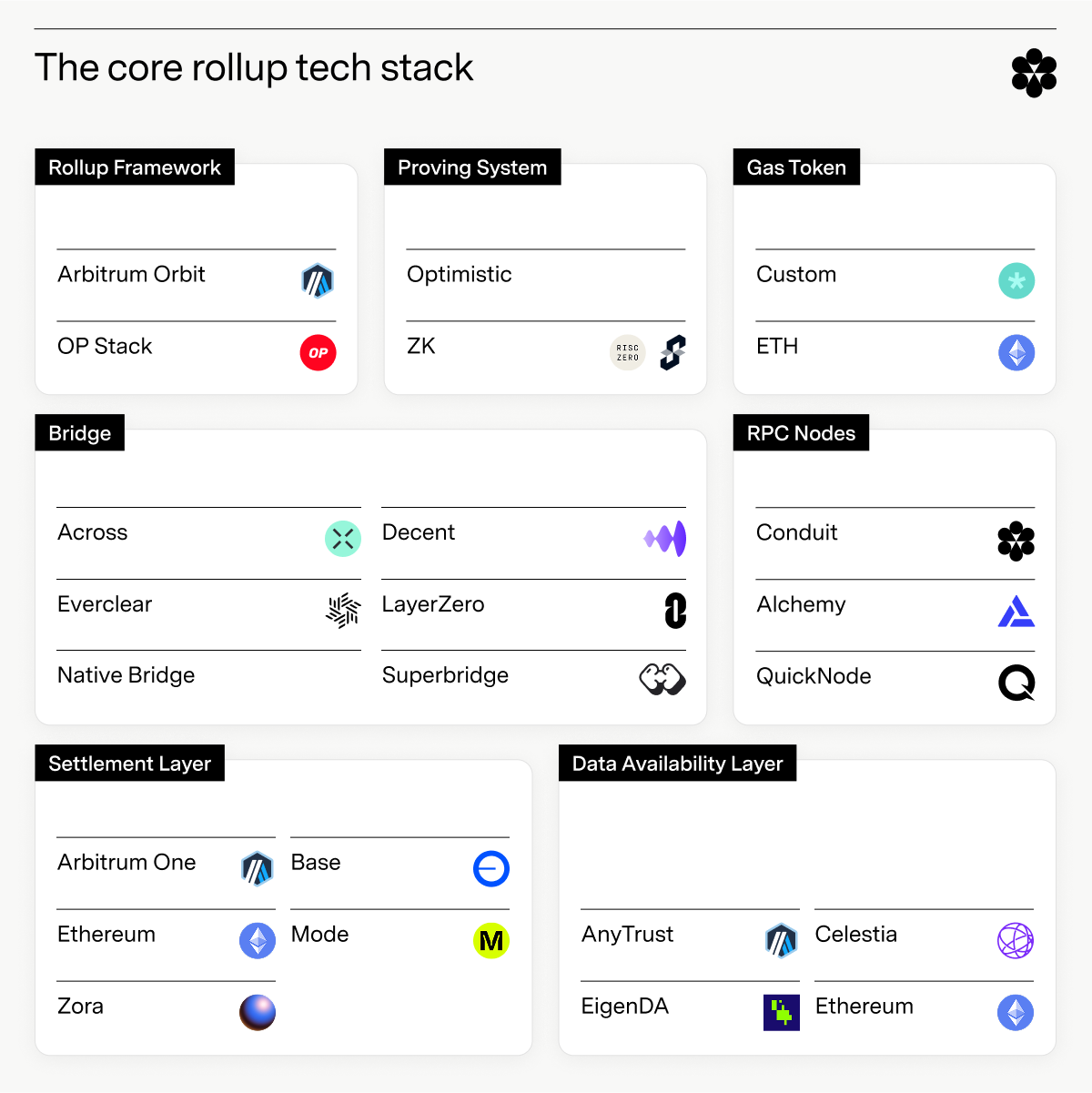
The core rollup stack is made up of seven key components:
- Rollup framework
- Settlement layer
- Data availability layer
- Proving system
- Gas token
- Bridge
- RPC nodes
These are the bare bones components that must be present for the rollup to function. However, there are several other components rollup operators can integrate to unlock new functionalities.
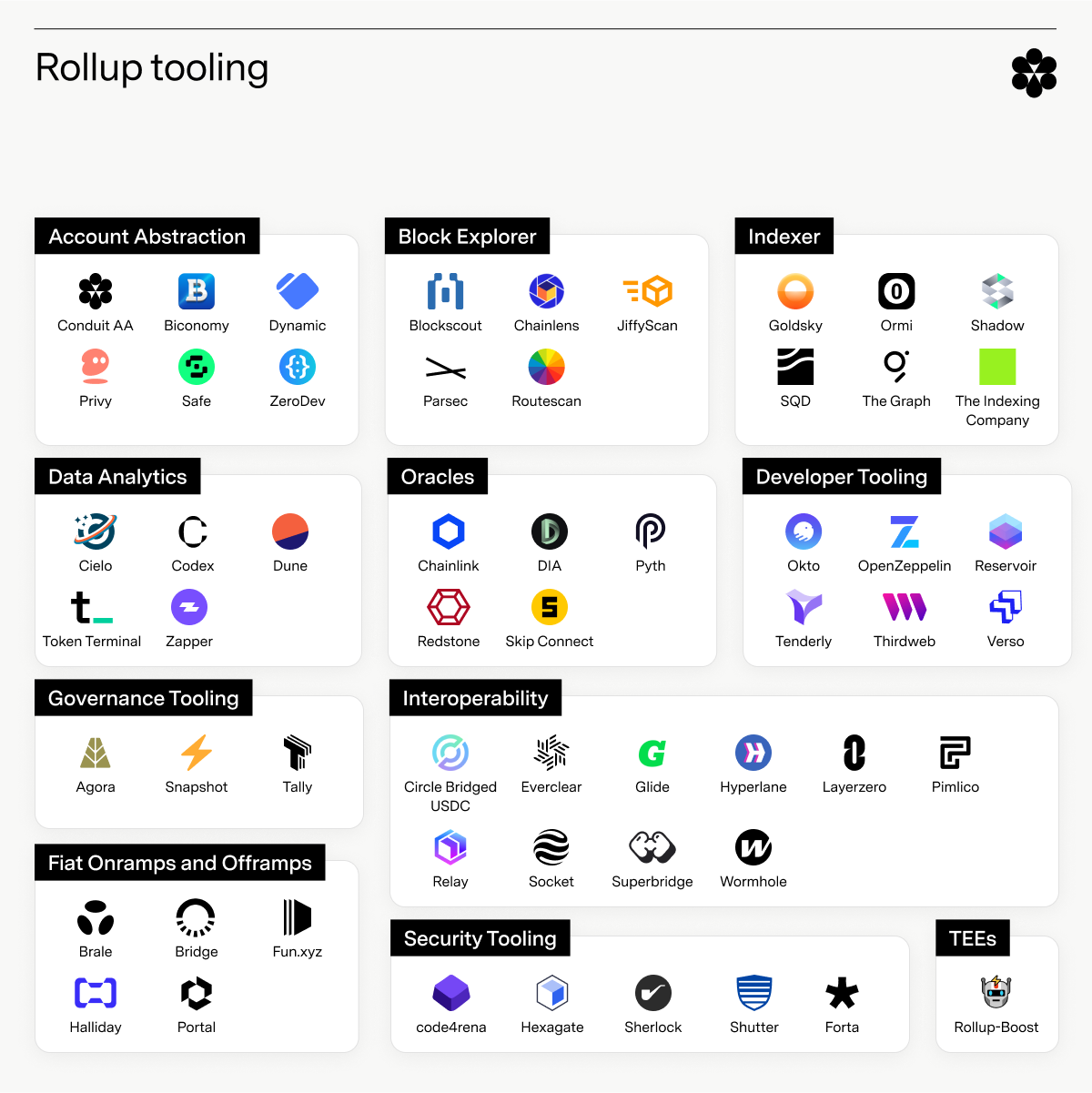
These include:
- Account abstraction
- Block explorer
- Indexer
- Data analytics
- Oracles
- Developer tooling
- Fiat onramps and offramps
- Governance tooling
- Interoperability
- Security tooling
- Trusted Execution Environments (TEEs)
We’ll examine each of these below.
Rollup framework
A rollup framework is a set of tools, protocols and infrastructure designed to simplify the creation and deployment of rollups. It provides developers with the building blocks to construct a rollup, while still allowing for significant customization through modularity – builders can still pick from a number of options for other components of the stack while still staying within the overall framework. Rollup frameworks allow developers to focus on their application’s needs without having to build the rollup from scratch.
The two most widely used rollup frameworks are OP Stack and Arbitrum Orbit.
OP Stack is the rollup framework designed and maintained by the Optimism Collective. OP Stack rollups have the option to join the Superchain, a network of OP Stack rollups that will eventually achieve native interoperability, and who contribute a share of revenue to the Optimism Collective. The Superchain vision has helped Optimism cultivate one of the strongest communities in Ethereum.
Arbitrum Orbit is the rollup framework designed and maintained by Arbitrum. Orbit has faster block times than the OP Stack, which can make it better for use cases like onchain gaming that demand real-time transaction finality. Orbit also provides exclusive access to AnyTrust, a DA layer built by Arbitrum.
Both OP Stack and Arbitrum Orbit utilize the optimistic rollup proving system, though recently developers have built tooling that allows OP Stack rollups to incorporate the ZK proof system as well.
The rollup framework in many cases will also determine the sequencer the rollup uses.
The sequencer is the specialized node on the rollup responsible for submitting the rollup’s transactions to Ethereum mainnet (or the underlying L2 in the case of an L3 rollup). In this capacity, the sequencer orders the transactions, groups them into batches, updates the rollup’s state following each batch, and then posts each batch plus the state update to Ethereum.
Each rollup framework comes with a default sequencer implementation, but developers can also use custom sequencer solutions designed to fit their exact use case. For example, Conduit’s G2 Sequencer provides much higher throughput, allowing the most compute-intensive apps to sustain performance even during periods of high growth.
Proving systems
Proving systems are key to maintaining trust in rollups. A proving system is a process designed to catch fraudulent or invalid transactions that may occur on the rollup before they’re committed to the L1. There are two predominant proving systems for Ethereum rollups:
- Fraud proofs, used by optimistic rollups
- Validity proofs, used by ZK rollups
Let’s look at both below.
Optimistic rollups and fraud proofs
Optimistic rollups use a proving system known as fraud proofs to ensure transaction validity. Under this model, all transactions are assumed to be valid by default, hence the “optimistic” name. But, in order to account for invalid transactions, optimistic rollups incorporate a seven-day challenge period before each batch of new transactions is committed to the L1 for finality. During the challenge period, any validator can challenge any transaction they believe is invalid by submitting a fraud proof, which contains their evidence that the transaction is invalid. The dispute resolution process then begins, and the L1 smart contract governing the rollup checks all of the transactions in the batch to determine if the fraud proof is correct and the challenged transaction is in fact invalid.
Crucially, both the block builder responsible for submitting transactions (usually the rollup’s sequencer) and the party challenging a transaction have an incentive not to lie – that incentive is the bond they put up. The block builder submits a bond – that is, a sum of ETH – with each new batch of transactions they submit. If the transactions are found to be valid at the end of the seven-day challenge period, the block builder gets the bond back. If not, they lose some or all of the bond. Likewise, a validator must also submit a bond if they submit a fraud proof. If they’re wrong and the transaction is valid, they lose some or all of their bond.
The optimistic rollup model is considered secure because of how it incentivizes honest behavior, and because anybody can act as a validator and submit fraud proofs permissionlessly, limiting the possibility of collusion – it only takes one honest validator to catch malicious transactions. However, there’s always the possibility that a rollup doesn’t have that one honest validator – the proving system still requires human participation, and isn’t automatic. Likewise, the seven-day challenge period also impacts user experience, as it means users must wait seven days to withdraw funds from the rollup back to the L1.
ZK rollups and validity proofs
ZK rollups (Zero-Knowledge Rollups) use cryptography to prove the validity of rollup transactions. Each time the rollup submits a batch of transactions to the L1, it also submits a cryptographic proof, known as a zero knowledge proof, proving the validity of the transactions. Zero knowledge proofs function such that the L1 smart contract governing the rollup can quickly verify that the proof is correct using cryptography, without actually viewing the transactions themselves.
The speed of ZK proving means that ZK rollups can finalize transactions much faster than optimistic rollups, at one hour versus seven days. However, ZK proving requires significant computing power – while the required power is falling quickly, it still adds costs. Traditionally, ZK proving has been incompatible with the Ethereum Virtual Machine (EVM), requiring ZK rollups to deploy their own specialized zkVMs, which can be difficult to implement and also make it harder for most developers to build apps on those rollups. However, this has changed recently with the introduction of tools like Succinct Labs’ OP-Succinct, which allows optimistic rollups to transition to ZK proving while maintaining EVM equivalence.
Settlement layer
The settlement layer is the blockchain the rollup is built on, and to which it submits batched transactions for verification and final settlement. Rollups began under the L2 model, with all of them using Ethereum mainnet as the settlement layer, and most still use that model today. However, many developers have now built L3s, which use existing L2s for settlement, most commonly Arbitrum One (example: Proof of Play) or Base (example: Donatuz).
Data availability (DA) layer
Data availability refers to rollups’ need to ensure that the transaction data they process off of the settlement layer, as well as the proofs of that data’s correctness, are available for any network participant to view. This is necessary to maintain trustlessness – if the data isn’t available, then the rollup can theoretically steal funds or publish false data. Under the optimistic rollup model, data availability is also key to ensuring participants can challenge invalid transactions. Data availability is also necessary for state reconstruction in the event the chain fails.
DA is a large cost of running a rollup, and the efficiency of the rollup’s DA solution is a significant determinant of how much activity it can process at once, and therefore of its overall performance.
Rollups today solve the DA problem in a number of ways:
- Posting directly to Ethereum. This is the most expensive DA method, though the recent development of Ethereum blobs via EIP-4844 has provided a cheaper method of storing compressed transaction data.
- Using a third-party data availability layer. Providers like Celestia, EigenDA, and Avail have developed networks dedicated to cheap, efficient data availability to rollups.
- Offchain DA. Some rollups use offchain solutions like external DA committees to store transaction data and make it available when necessary, though this generally reduces trustlessness and is viewed as a temporary solution. Arbitrum AnyTrust falls into this category.
Due to the costs involved and impact on decentralization and trustlessness, picking a DA layer is one of the most important decisions developers make in building a rollup.
Gas tokens
The gas token is the token that rollup users pay gas fees in, which accrue to the rollup’s sequencer and to any network participants the rollup may incentivize, such as external validators. The gas token is important for onboarding, as users will need to bridge it over to the rollup in order to conduct transactions. Most rollups use ETH as their gas token, but others use custom gas tokens — often either USDC or their own network or governance token. Utilizing the network’s own token as the gas token can enhance tokenomics, but any price volatility can result in lost value, as the rollup will have to swap the token into ETH to pay onchain costs like DA.
Bridges and interoperability
Bridges allow users to move funds between blockchains. For rollups, bridges are crucial first and foremost to onboarding. OP Stack and Arbitrum Orbit come equipped with their own native bridges that connect the rollup to Ethereum, and which are also used to submit fraud proofs to Ethereum as part of the security model. Native bridges allow for fast bridging to the rollup itself, but implement a seven-day waiting period for withdrawals back to Ethereum in order to account for the fraud proof challenge period. Many rollups choose to integrate third-party bridges like LayerZero or Decent to get around that waiting period, as well as to connect the rollup with more blockchains besides Ethereum (e.g. other L2s).
Other interoperability providers similar to bridges are allowing users to interact with specific smart contracts and apps on other chains from their current chain without needing to bridge funds over. Across is one example of such a provider.
RPC nodes
RPC nodes are essential for building apps on your rollup. RPC nodes are servers that enable apps to communicate with the rollup via RPC calls, and they enable core onchain operations like transactions, smart contract calls, and querying data like wallet balances. The most advanced RPC node providers use autoscaling frameworks to automatically scale available RPC nodes up and down with onchain traffic, ensuring that the rollup can remain operational through periods of heavy activity, without wasting RPC resources during periods of lighter activity.
Account abstraction
Account abstraction refers to tools and development practices that allow developers to improve onchain user experience by shielding them from things like seed phrases, gas payments, and other common sources of onchain friction. Account abstraction uses onchain infrastructure components like bundlers and smart accounts to enable things like:
- Conditional transaction execution. Account abstraction allows users to program their wallets to automatically carry out transactions under specific circumstances.
- Gas sponsorship. Onchain apps can pay for gas on users’ behalf or support gas payment in tokens other than ETH thanks to account abstraction.
- Session keys. Account abstraction allows users to continuously transact via an onchain app for a given period of time without needing to sign each transaction. This is especially valuable for onchain games and other apps that require sessions of sustained usage.
- Social recovery. Users can recover access to their wallets using trusted contacts or predefined recovery methods, rather than relying solely on a private key.
- Custom wallet logic. Users can implement custom rules for how their wallets interact with onchain apps, such as setting spending limits, time locks, and access restrictions.
Rollups on Conduit can use Conduit Account Abstraction through our partnership with ZeroDev. Other popular account abstraction providers include Biconomy, Privy, Safe, and Dynamic.
Indexer and data analytics providers
Indexers are tools developers use to access onchain data related to their rollup. Indexers make this possible by extracting data from the chain, putting it into a readable or queryable format, and surfacing it in a more convenient UI. Developers use indexers to access data related to rollup transaction history, smart contract logs, and event logs, which they can use to improve the product. Indexers also provide APIs for onchain apps to query the rollup’s data without needing to run a node on the network, making them important for third-party developers rollups want to attract. Popular indexers include Goldsky, Ormi, Shadow, SQD, The Graph, and The Indexing Company.
There are also many data analytics providers focused on making rollup data available to a public audience. Many rollups choose to integrate with these providers to equip crypto users and analysts with more information about the chain, fostering more awareness and usage. Dune, which allows anyone to run SQL queries on data for the blockchains it indexes, is the quintessential example here. Other popular data analytics providers include Token Terminal, Cielo, Codex, and Zapper.
Block explorers
Block explorers are web apps that allow users to view blockchain data related to specific:
- Addresses, e.g. Balances, recent transactions, etc.
- Transactions, e.g. status, timestamp, sender and recipient, amount, etc.
- Blocks, e.g. block number, timestamp, transaction count, validator or sequencer who produced the block, etc.
- Smart contracts, e.g. contract address, source code, logs, etc.
- Rollups, e.g. batch submissions to L1, DA status, fraud or validity proof updates, etc.
Block explorers typically follow a format similar to that of Etherscan or Blockscout, the latter of which is widely used by rollups. Some, like Parsec, offer more advanced data visualization and customization. Other popular block explorers include Routescan, Chainlens, and JiffyScan.
Oracles
Oracles are onchain infrastructure that bring external data to a blockchain in a reliable, verifiable way. This is essential, as many onchain apps need offchain data that blockchains have no native way of accessing. For instance, a DEX on your rollup may use an oracle as a safety mechanism to ensure that the assets it’s pricing are in line with the rest of the market, e.g. CEXs and DEXs on other chains. Another common oracle use case is the VRF (verifiable random function) oracle, which generates verifiably random numbers – this is important for apps like onchain games and gambling protocols, which require trustless randomization for fair gameplay.
Chainlink is the most recognizable oracle provider in crypto. Other popular oracle providers include Pyth, DIA, Redstone, Skip Connect.
Fiat onramps and offramps
Fiat onramps and offramps allow users to convert fiat currency into crypto and vice versa. While CEXs are the most commonly used platforms for fiat on and offramping, many rollups integrate third-party tooling to bring this capability to their rollup as well, giving users another way to onboard onto the chain besides bridging. Popular fiat onramp/offramp providers for rollups include Brale, Bridge, Fun.xyz, Halliday, and Portal.
Governance tooling
Many rollups used governance tokens to allow their community or DAO to vote on decisions regarding the rollup’s technical and business strategy. Governance tooling providers offer products to make the voting process, such as:
- Voting platforms for governance token holders
- Customization of voting rules like ranked choice, required participation for quorum, voting power determinants outside of governance token balance, and more
- Delegation tools allowing governance token holders to transfer their voting power to another party
- Streamlined proposal processes via categorization of common proposals like upgrades and treasury transfers
- Smart contracts to trigger onchain actions as a result of governance votes automatically
These tools allow rollup developers to focus on building their chain without getting bogged down in the nuts and bolts of governance systems. Popular governance tooling providers include Agora, Snapshot, and Tally.
Security tooling
Security is of the utmost importance in cryptocurrency, as hacks have destroyed protocols and resulted in billions of dollars in lost value. Many rollup builders partner with security providers who audit their rollup for vulnerabilities, and offer tools for detecting malicious transactions before they’re carried out. Popular rollup security tooling providers include Forta, Hexagate, Sherlock, Shutter, and code4rena.
Trusted Execution Environments (TEEs)
A TEE is a walled off computing environment where code can be executed securely, without any sensitive data being leaked. Teams like Flashbots and Phala Network are exploring new, onchain use cases for TEEs, mostly centered around providing computing power in a decentralized manner. For example, Flashbots’ Rollup-Boost project allows rollups to put their block builder in a TEE, which allows them to set fair, transparent block building rules that protect users from reverted transactions and predatory forms of MEV. Other applications, such as TEE-based validity proofs, are expected soon. Phala, on the other hand, uses TEEs to provide computing power for onchain AI applications.
Rollup use cases
Virtually any kind of protocol or app operating on another blockchain could conceivably launch their own rollup, as well as ecosystems that might otherwise build a separate L1. We’ll look at the most popular rollup use cases and segments below, as well as emerging ones.
Gaming
Historically, video games have been some of the biggest drivers of technological innovation, and the same is true for rollups. Onchain games are uniquely positioned to take advantage of rollups, as it requires large amounts of computing power to run a modern video game on a blockchain. Accessing the necessary compute on Ethereum L1 or another shared blockchain is often economically infeasible due to gas fees, and even ignoring fees, most L1s are simply incapable of providing the necessary gas for a sophisticated onchain game with even a few hundred concurrent players.
Developers building an onchain gaming rollup must optimize for computing power and throughput, much of which is determined by the power of the rollup’s sequencer. Data availability is also crucial, as onchain games process large amounts of data that must be periodically committed to the L1 – those commitment transactions are usually the largest onchain expense of running a rollup. Onchain gaming developers must choose a DA provider that enables them to submit as much transaction data as possible per transaction, to minimize the frequency of expensive DA transactions.
Account abstraction is also crucial for onchain games because each in-game action typically has a corresponding onchain transaction – if the user needs to sign each of those transactions individually, gameplay will suffer. Account abstraction allows those transactions to be signed automatically under the hood, so that users can play without interruption.
What the builders say: Proof of Play Head of Business Development Dith on gaming rollups
What benefits can onchain games get from launching their own rollup?
The number one benefit is throughput. If you want to build a fully onchain game that’s actually fun and performs seamlessly at scale like a web2 game, you need your own dedicated blockspace. This is also an economic necessity – gas fees will kill you on a shared chain. On a rollup, all you have to worry about is DA, but you can mitigate those costs by running an L3 and using a modular DA solution.
What are the most important things for builders to keep in mind when building out a gaming rollup?
You must not compromise when it comes to infrastructure partners. Performance, reliability, support are all very important table stakes. The right partner here will ensure you can stay focused on your core product without worrying about any of these things.
Besides the operational overhead, this is also important because gaming puts such a uniquely large strain on onchain infrastructure. Rollups are still a relatively new technology, and we’re often running into unique scaling barriers no other team has run into before – you need to be working with top experts in the field to break through those barriers.
What are your predictions for onchain gaming in 2025 and beyond?
I predict that more and more gaming teams will see the unique benefits of building onchain. For example, composability – onchain games are natively moddable, which allows the community to create clients & apps, or remix & extend the game as they’d like.
Onchain gaming also has the potential to shift the LTV curve, by aligning game developers with the game’s secondary market, creating new revenue streams that grow with the player base. This potentially means that player acquisition & retention is more profitable in onchain games than offchain games.
DEXs
DEXs are one of the most popular onchain products, and many are now rolling out their own rollups. The dedicated blockspace of rollups allows for lower fees and faster transaction times, with less likelihood of falling victim to predatory MEV tactics – all of this contributes to better user experience.
DEX traders need speed, as they often have a short window to take advantage of market opportunities before prices change. DEX rollups should therefore optimize for fast block times so that trades can be settled as quickly as possible. Many DEX rollups on the cutting edge are also beginning to experiment with TEE-based block builders, which allow them to execute trades faster with guaranteed inclusion within blocks. TEE-based block builders also allow rollup operators to limit reverted transactions and exert more control over MEV, preventing predatory practices like frontrunning.
Interoperability is also important for DEX rollups, as it allows the DEX traders to tap into the liquidity of other chains and gain access to a wider variety of assets. DEXs also need to integrate pricing oracles from the best possible providers in order to ensure all assets are priced accurately at all times.
Finally, DEX rollups should also partner with a powerful DA provider, as this lets them keep user fees and settlement costs as low as possible.
How DEX rollups work: Insights from Derive
Derive is one of the biggest, fastest-growing derivatives DEXs in the Ethereum ecosystem, and it runs on a Conduit rollup. Here are some key insights from our recent case study with Derive to show you what considerations matter when building a DEX rollup.
Why Derive launched a rollup
Derive initially built its DEX as a protocol on OP Mainnet, powered by an AMM. But the team soon decided to switch to an orderbook, with all risk assessment and trade settlement occurring onchain. This drastically increased Derive’s gas usage needs. “An ordinary swap on Uniswap is about 100,000 gas. But a risk check on Derive can add between 1 million and 60 million gas depending on the number of positions the trader holds – it’s very mathematically intensive,” said Derive Head of Engineering Josh Kim. “It wasn’t even really a question of expense. It would’ve been impossible to get the throughput we needed if Derive ran as a protocol on another chain.”
How gas limit increases make Derive a better derivatives DEX
Early on, Derive worked with Conduit to implement the Geth upgrade on Derive’s RPC nodes and raise its gas limit from 30 Mgas/s to 400 Mgas/s. The increase allowed Derive to double the number of maximum positions traders could take from 64 to 128. “2x may not sound like much but it enables market makers to be many multiples more capital efficient because of the way portfolio margin works. That brings more market makers to our platform, which means the spreads can get tighter and tighter for users,” said Kim.
Account abstraction drives better UX for Derive
Derive uses Conduit Bundler – a part of the Conduit Account Abstraction package – to streamline the trader experience. “We want Derive’s UX to feel as smooth as a CEX,” said Kim. “So we don’t want users having to sign each individual transaction when they trade. Conduit Bundler takes care of that.” While Derive previously utilized a bundler from another provider, switching to Conduit Bundler allows Derive to keep more of its infrastructure on one central platform, cutting down on operational overhead.
Ecosystem
More and more teams are building rollups to act as ecosystems where other developers can build and deploy protocols. Projects like Arbitrum, OP Mainnet, Base, Mode, Gravity, and more have shown that this can be a winning strategy.
Ecosystem chains need to cater to developer experience, which means choosing a rollup framework that can best support the kinds of projects they envision deploying. Tools like Stylus from Arbitrum can greatly expand the potential pool of developers for an ecosystem chain by providing support for more widely known programming languages with a footprint beyond crypto. In Stylus’ case, those languages are Rust, C, C++, and others that compile down to WebAssembly (WASM).
There are other third-party tools that can help attract developers as well:
- Account abstraction: Developers are more likely to build on your chain if they know they have access to account abstraction tools that reduce friction and make user onboarding easier.
- Interoperability: It’s easier for developers to access the liquidity they need to get apps off the ground if your ecosystem rollup is interoperable with other chains. Fiat onramps can serve a similar purpose, as they make it easy to draw liquidity from offchain sources.
- Smart contract libraries. These libraries speed up app development by giving builders access to pre-written code for key app components.
Those are just a few examples. The key point though is that any tool that can make developers’ lives easier is another reason for them to build on your rollup.
Ecosystem rollup teams also need to work with top-tier RPC node providers, as any app running on the chain will rely on these nodes. High uptime and autoscaling functionality is important for ensuring that RPCs remain active performant as traffic grows, or in the case of network disruptions. Important events for ecosystem chains like an airdrop, token generation event (TGE), or launch of a highly-anticipated app put an especially big load on RPC nodes — these events can become failures if the RPC provider isn’t up to task.
Using a custom gas token is another tactic many ecosystem chains should consider. Custom gas tokens allow ecosystems to employ tokenomics that set them apart from other ecosystems, and potentially even offer native yield on the gas token, providing users more incentive to bridge to the chain.
Onchain social
Many builders are working on putting the next generation of social media platforms onchain, with censorship resistance and opportunities for users to earn crypto for their posts. Rollups are proving to be a strong option for these projects, because they give social platforms the throughput they need to scale to large userbases and maintain performance during viral moments.
Autoscaling RPCs are essential here. If an onchain app reaches a growth inflection point or has a viral post that attracts more users, autoscaling will kick in and give the chain access to more RPCs to handle the increase in requests, and then automatically scale back if traffic falls again so as not to waste resources.
Onchain social builders should also work to choose a rollup framework and settlement layer that aligns with the audience they’re targeting. For instance, while it doesn’t operate as a rollup, the onchain twitter alternative Farcaster is a good example of a team choosing the right place to build. Farcaster launched on Base, at a time when Base was growing quickly and attracting the attention of influential crypto participants. Building on Base allowed Farcaster to become the go-to social protocol for this growing community.
How onchain social rollups work: Insights from Zora
Zora Network provides an Instagram-like social feed where creators can monetize their posts by allowing other users to mint them as NFTs, all on a Conduit rollup. Here are some key insights from our recent case study with Zora on how they built the optimal rollup for their use case.
Best-in-class RPCs make viral moments successful
As a social platform, Zora needs to be able to capitalize on viral moments, such as when users fought to mint its Total Solar Eclipse NFT, in honor of the east coast U.S. eclipse in April 2024. Zora Network’s TPS shot up to 13.1 and RPC requests hit 12,900 per second. Autoscaling RPCs from Conduit Nodes ensured Zora’s chain continued to perform through the sudden increase in activity.
DA improvements save Zora money
As a high-activity social network, Zora’s onchain DA costs were high initially, reaching up to 179 ETH per month. When Zora switched to Ethereum blobs for DA following the Optimism Ecotone upgrade, DA costs fell to 1-2 ETH per month. Any chain gaining significant traction should look to minimize DA costs as much as possible, whether through upgrades for native DA as Zora did, or through alt-DA providers if they fit into the chain’s risk framework. More generally, rollups should work with infrastructure partners who are capable of implementing network upgrades smoothly and quickly.
Web3 consumer
One emerging but broad category of crypto is web3 consumer, which you can think of as a catch-all for projects trying to recreate popular web2 apps onchain.
Similar to gaming rollups, web3 consumer apps should prioritize power and throughput. Running a web2-style consumer app onchain at scale requires immense throughput, as a large quantity of transactions need to be processed quickly for the app to run smoothly. This is especially important given that web3 consumer apps will be trying to draw users — many of whom are not crypto native — away from their web2 counterparts, which have typically set a high performance standard.
Account abstraction is also important here for largely the same reasons. Users comparing a web3 consumer app to web2 incumbents will expect smooth onboarding flows, email logins, session keys, and slick UX features. If they have to continuously sign transactions or refill their wallets with gas tokens, they probably won’t stick with the product. Luckily, account abstraction tools can solve this problem by abstracting away the unwieldy parts of onchain UX and allowing apps to sponsor gas payments.
The rollup landscape by the numbers
Below, we take a data-driven look at the rollup ecosystem today, with a focus on the technical components they utilize both overall and across different use cases. Some charts display data for the entire rollup ecosystem based on numbers from L2Beat, while others look only at rollups in the Conduit ecosystem.
Total rollups:
L2Beat tracks 129 rollups across the entire Ethereum ecosystem [1]
Conduit powers over 50 mainnet rollups [2]
Rollup frameworks:
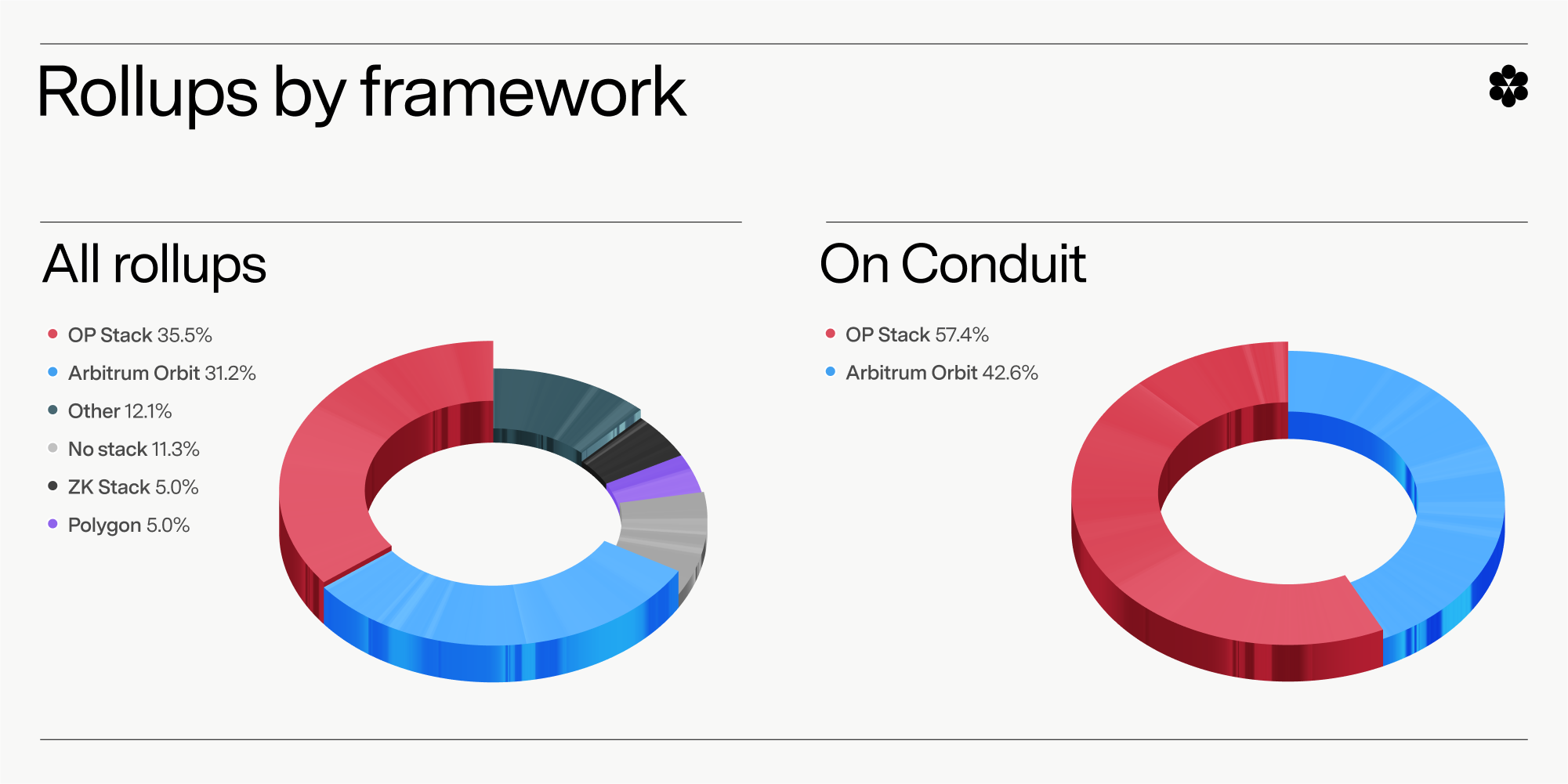
Across all rollups, OP Stack is the most widely used framework, followed by Arbitrum Orbit. This holds true within the Conduit ecosystem as well. The third-most popular option is a self-built stack, followed by several more niche stacks used by a few rollups apiece.
Settlement:
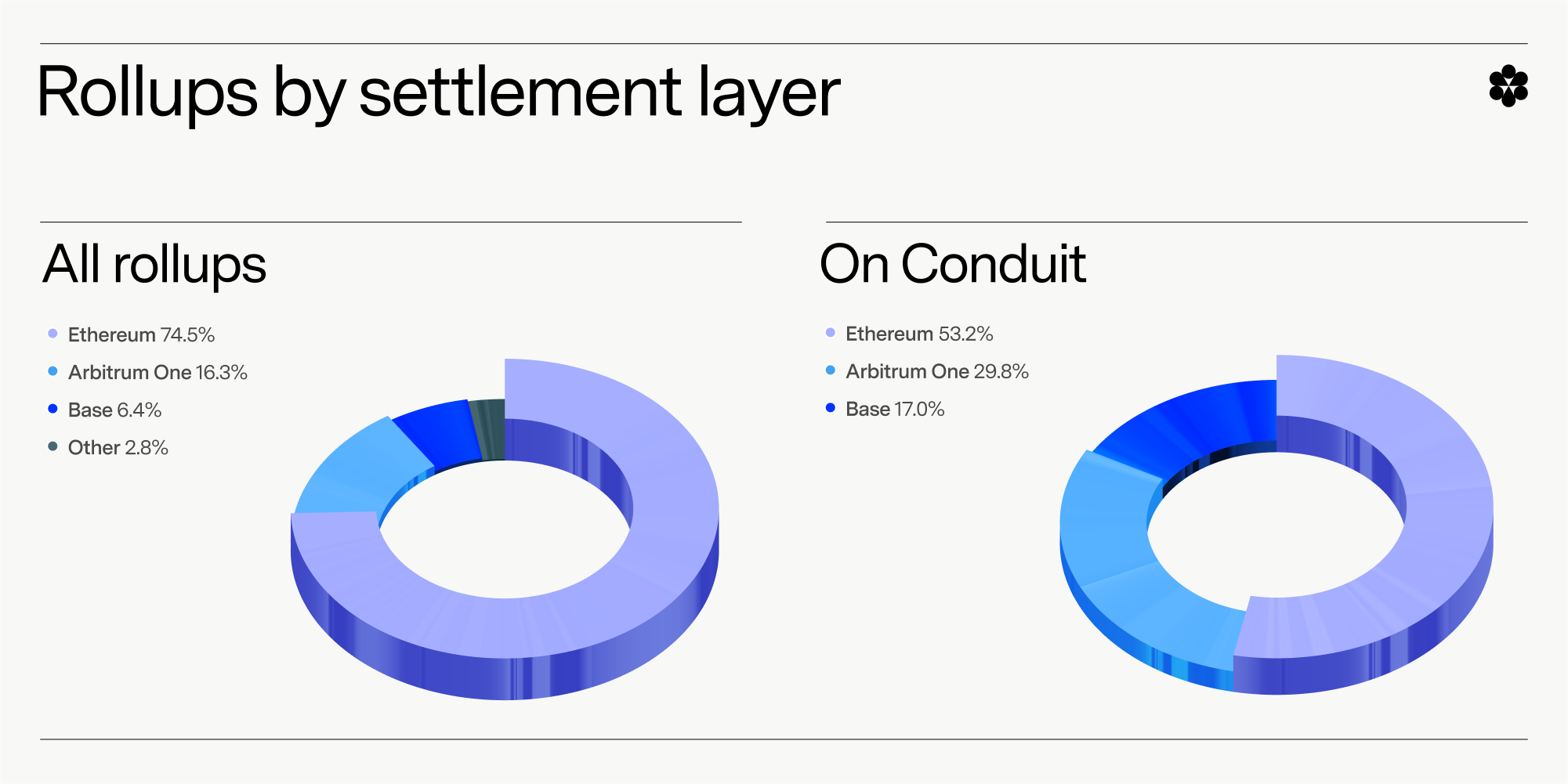
75% of all rollups tracked by L2Beat are L2s built on Ethereum. 16% are Arbitrum L3s, and 6% are Base L3s.
Within the Conduit ecosystem, only 53% of rollups are Ethereum L2s. Arbitrum One is still the most popular settlement layer for L3s on Conduit, but its dominance isn’t as pronounced, as 17% of Conduit rollups overall are Base L3s.
Much of this is driven by Conduit’s support for gaming rollups, which disproportionately deploy as L3s compared to rollups in other segments. Onchain games must process a great deal of data and transactions, and L3s allow them to do this at a much lower cost-per-transaction for users. The trend is also largely driven by Conduit’s early support for L3s, which began with a heavy focus on Base.
Data availability:
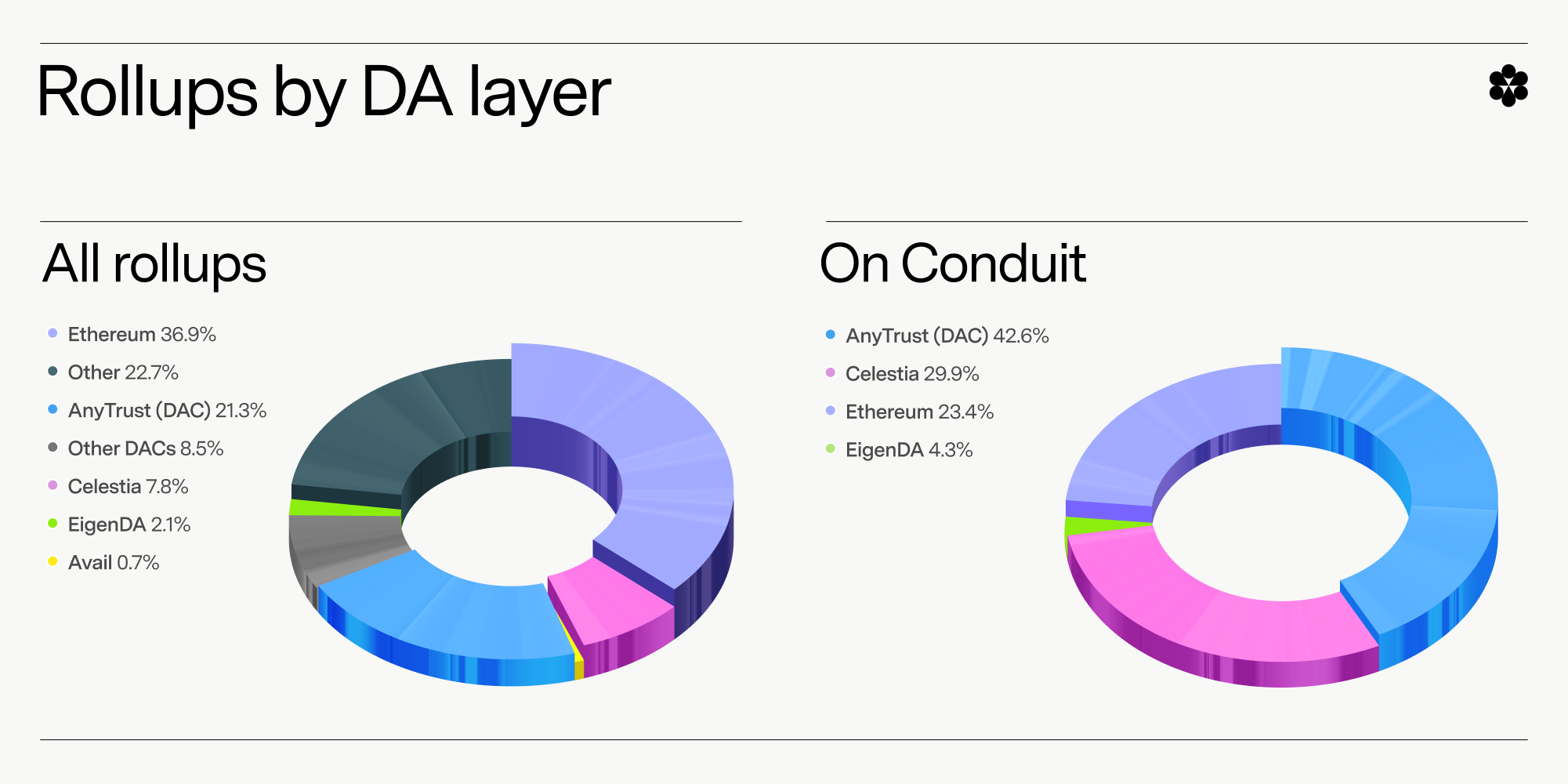
Ethereum is the most popular DA choice for rollups, accounting for 37% of all rollups tracked by L2Beat. Arbitrum AnyTrust is second at 21%, with Celestia and DACs taking close to 10% each.
Conduit rollups, on the other hand, heavily favor AnyTrust at 43%, followed by Celestia at 30%. Roughly one quarter of Conduit rollups use Ethereum for DA, placing it third.
The difference is primarily driven by Conduit’s focus on rollups pursuing high-throughput use cases. Ethereum provides EIP-4844 blobs for rollup DA, which can handle approximately 768 kilobytes of data per block. AnyTrust DA provides 10,000 kilobytes of data per block, and with 250ms blocktimes compared to Ethereum’s 12 second block times, the difference in maximum data processed per second is even greater. Similarly, Celestia supports 1,800 kilobytes ber block, with 6 second blocktimes. In general, rollups processing larger amounts of computing power and data will need higher-throughput alt-DA options rather than Ethereum DA.
How do these DA options compare on cost? Below, we look at rollups’ cost per megabyte (MB) of data settled for different DA solutions for which we have sufficient real-world data. We’ll compare costs for L2s and L3s separately, as L3s pay significantly less by virtue of the fact that they settle transactions on another L2.
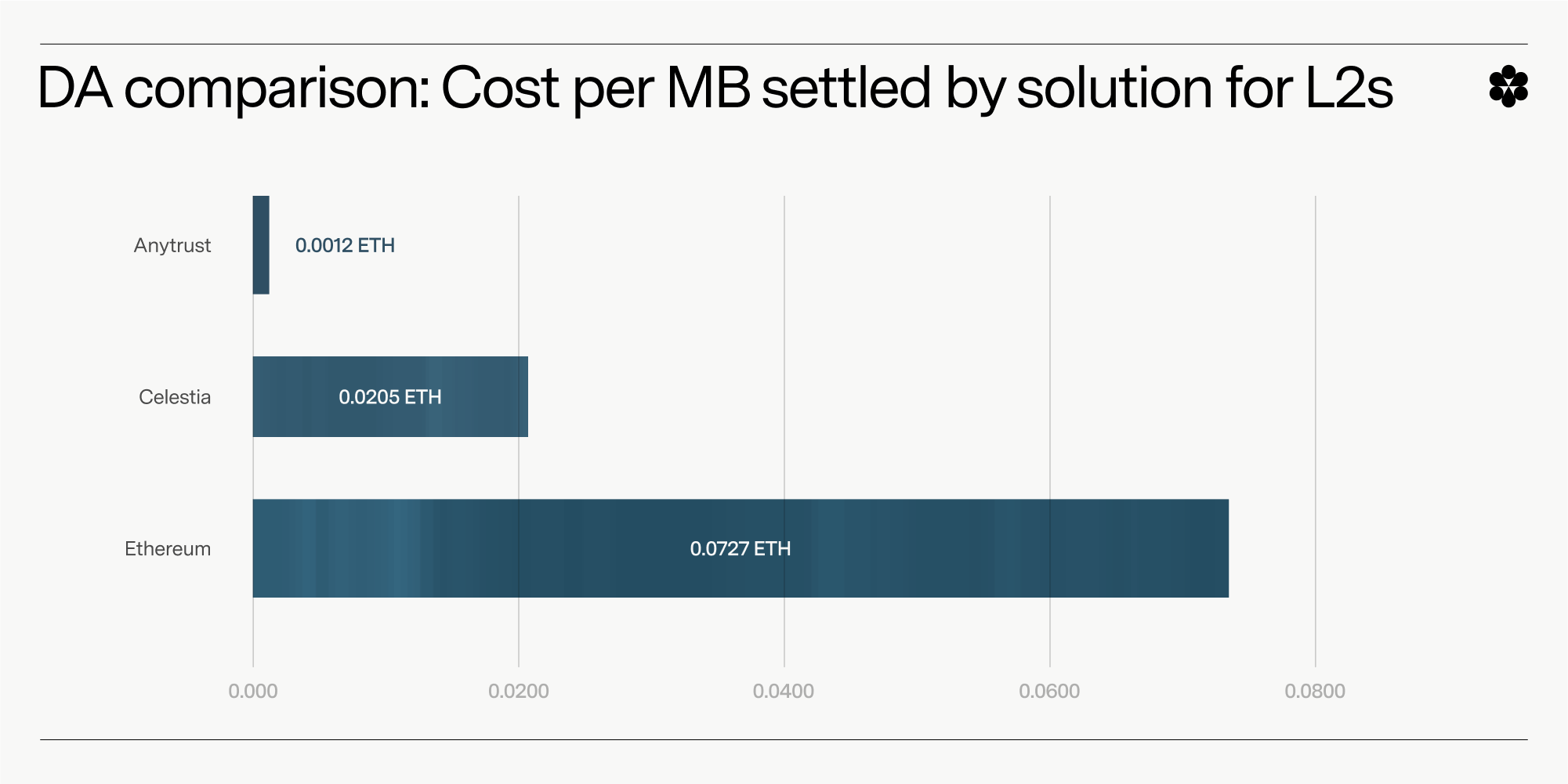
Unsurprisingly, Ethereum DA is the most expensive option for L2s. Celestia is 72% cheaper at 0.02 ETH per MB, vs. 0.07 for Ethereum. AnyTrust is significantly cheaper than both though at 0.0012 ETH. However, it must be noted that AnyTrust operates on the data availability committee (DAC) model, meaning it’s less secure, decentralized, and transparent than Ethereum and Celestia.
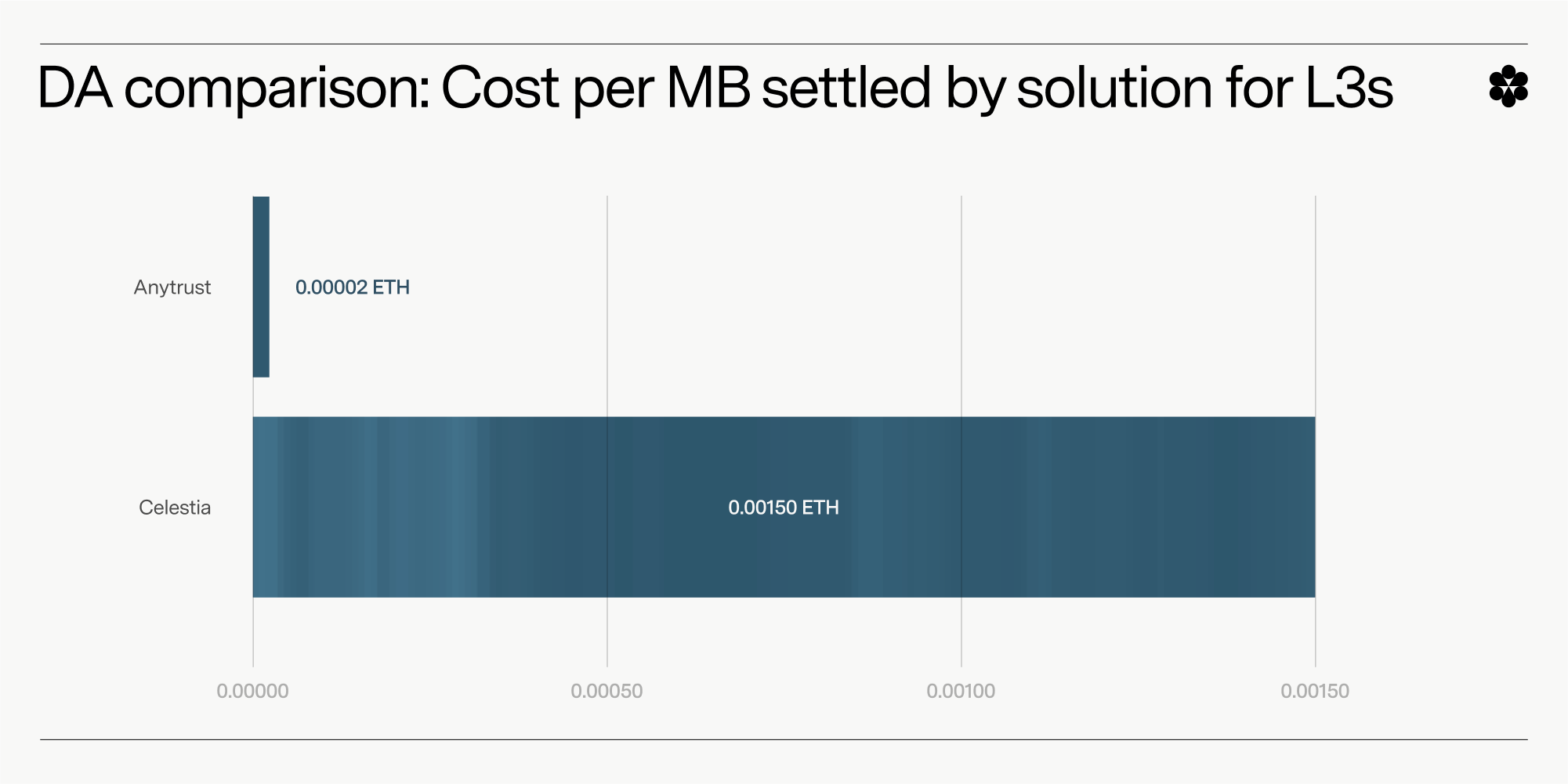
For L3s, we only have sufficient data to compare AnyTrust and Celestia. AnyTrust comes out significantly cheaper, at 0.00002 ETH per MB, versus 0.0015 for Celestia.
These cost comparisons are important for rollup teams to consider, as DA is typically the biggest onchain expense of running a rollup. The data suggests that operating as an L3 with Arbitrum Anytrust provides the cheapest possible DA, making it a good option for ultra-high throughput apps – again though, that low cost comes at the expense of security.
Proving system:
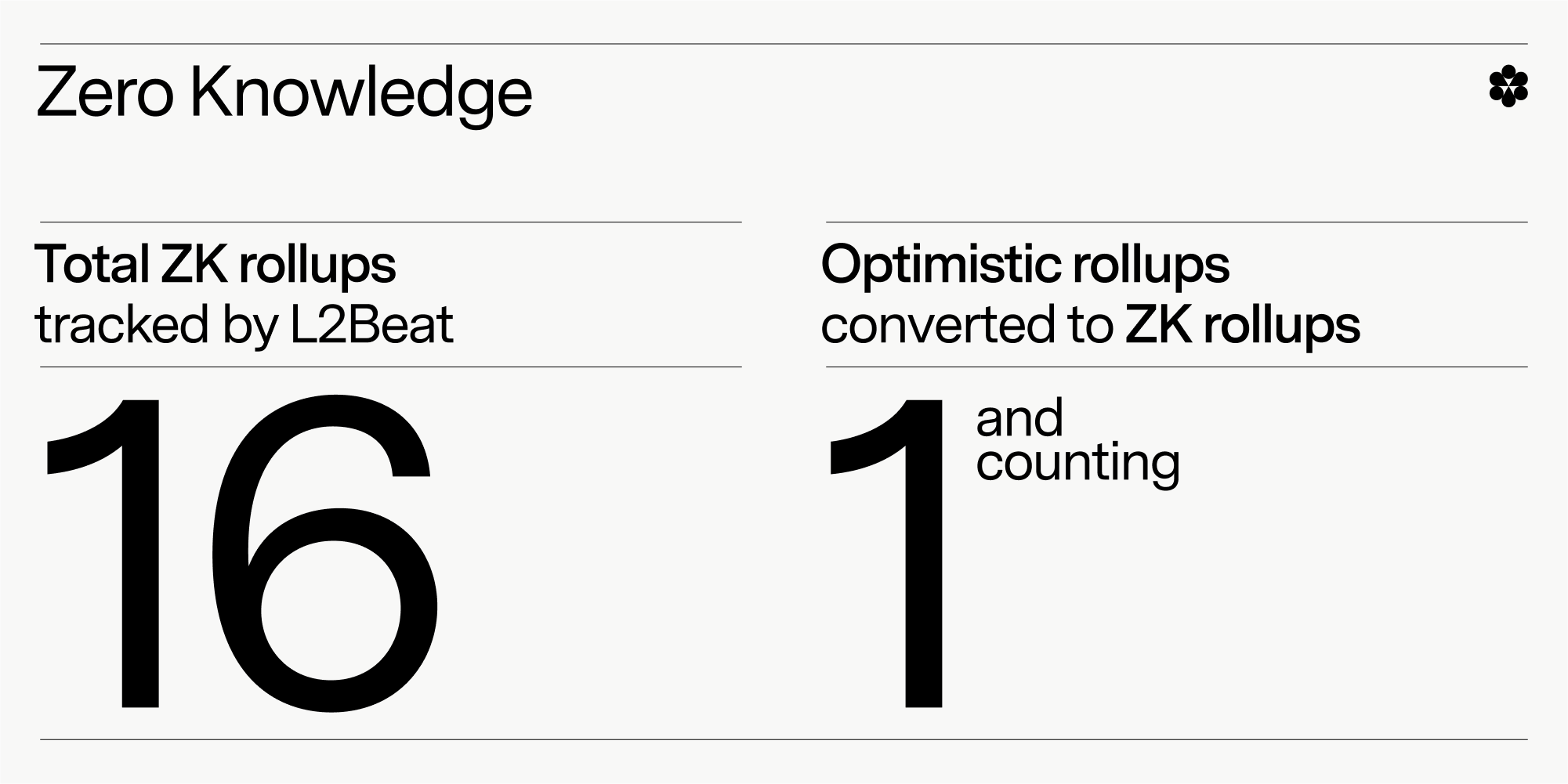
There are 16 ZK rollups live on mainnet today according to L2Beat, accounting for 11% of the total.
One of those rollups has converted from optimistic to ZK: Phala Network, powered by Conduit. We expect that number to grow in 2025. It’s only recently with the launch of zkEVMs like Succinct Labs’ OP-Succinct and Kailua’s RISCZero that rollups deployed with the OP Stack framework can convert from optimistic to ZK. Prior to that, developers had to build their rollup for ZK proving from the ground up, which requires significantly more development resources, and limits the developer pool who can then build apps on top of the rollup. zkEVMs are still in their early stages, but we expect many more teams to embrace the flexibility they provide to deploy as a ZK rollup while still maintaining the optimistic EVM frameworks most crypto developers are familiar with.
Rollup tech stack by segment
Below, we’ll dive deeper and look at rollup tech stack by rollup segment, to see how different use cases affect rollup teams’ infrastructure choices. Please note that the use case data here reflects only Conduit-powered rollups.
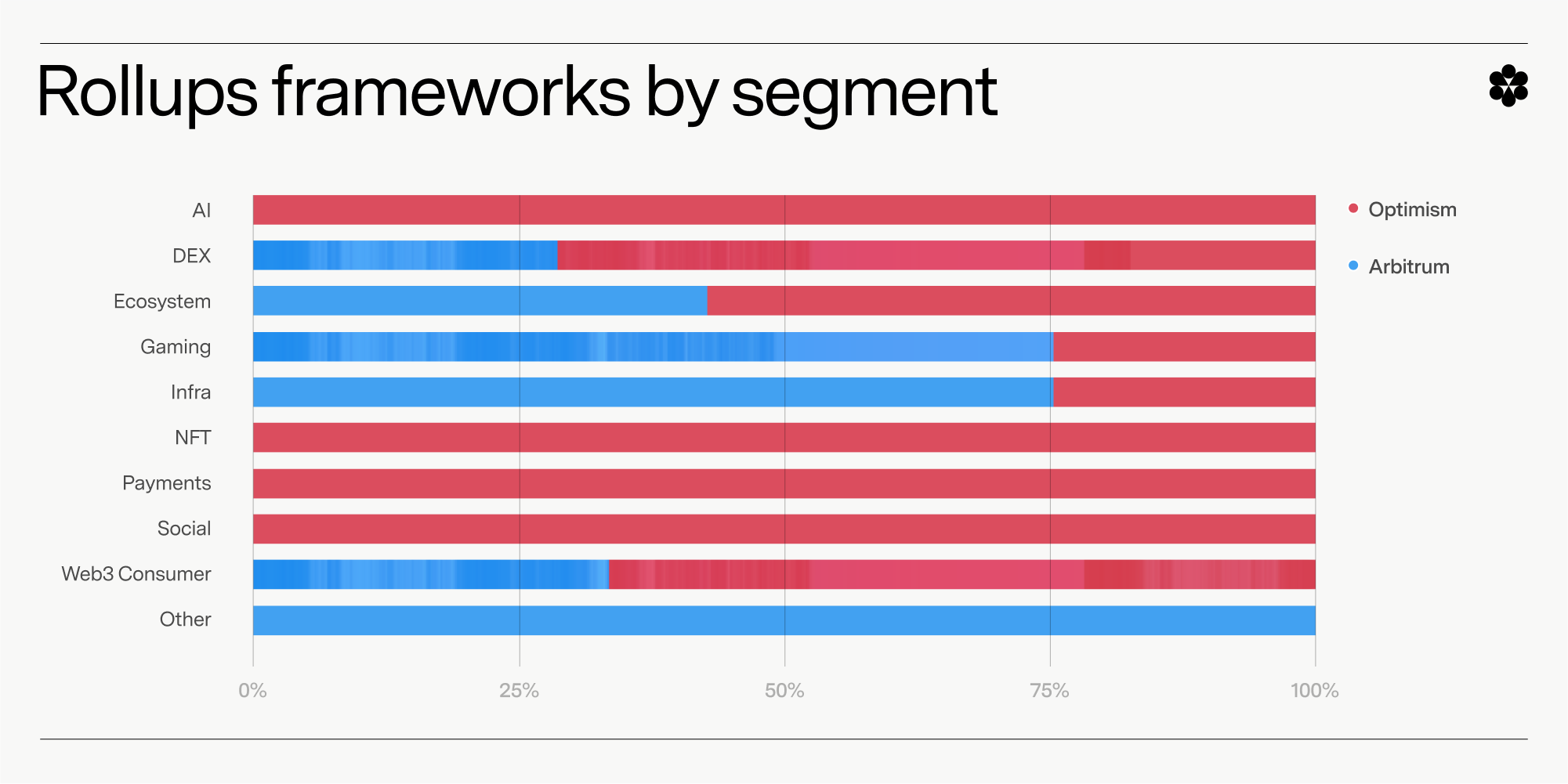
While the OP Stack is the most popular, Arbitrum Orbit dominates for both gaming rollups and rollups that function as an infrastructure layer for other onchain applications. Onchain games have embraced Arbitrum largely due to its faster blocktimes, which are necessary to finalize the transactions underlying gameplay quickly and avoid latency for players. Infrastructure is a much broader rollup segment, but many chains in this category also need fast settlement times.
OP Stack, meanwhile, is the leader for rollups supporting DEXs, NFTs, AI, and several other use cases. The interoperability promised by the eventual Optimism Superchain may be driving this decision for many, as well as the Optimism Foundation’s focus on public goods funding.
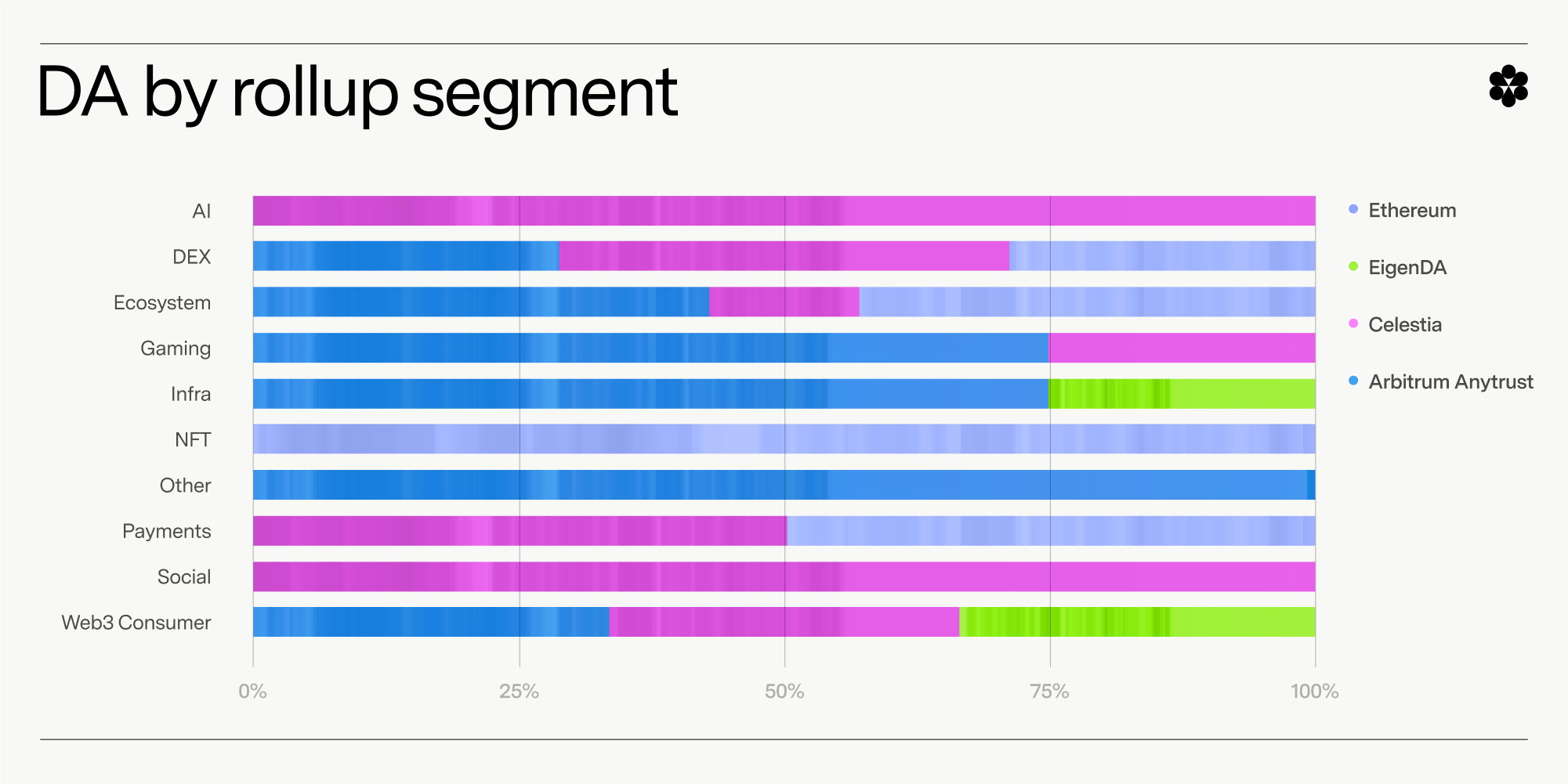
Ethereum dominates as the DA layer of choice for NFT-centric rollups, and also has a significant share of chains in the ecosystem, payments, and DEX segments. Alt-DA providers lead in higher-throughput use cases, and in particular those recreating web2 products onchain, such as consumer apps and social media. Gaming is a great example — AnyTrust is the DA of choice there, largely due to the large number of gaming chains that build with the Orbit stack and then opt to use Arbitrum for other parts of the rollup stack as well.
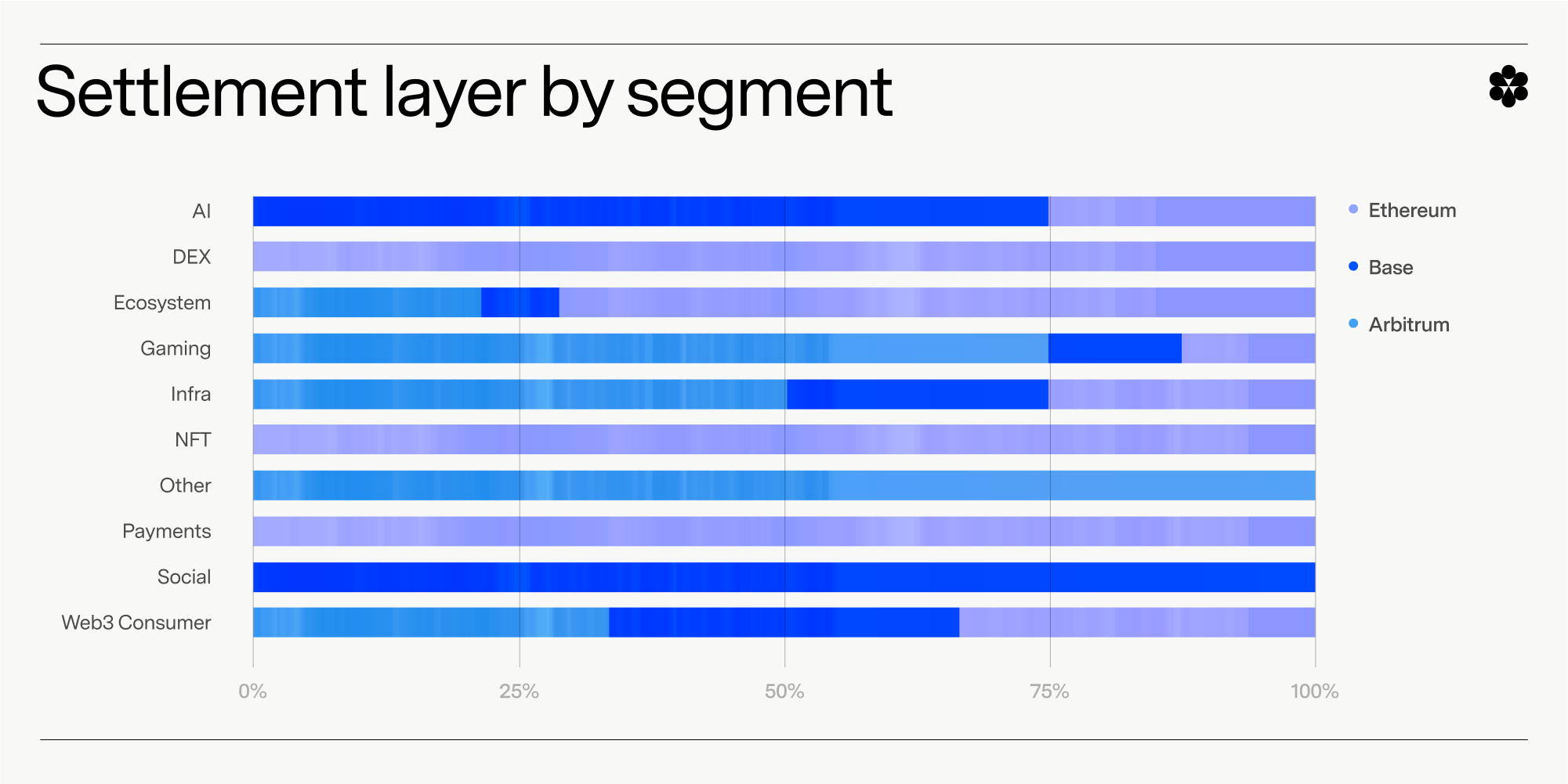
Similar to the trends in DA, Ethereum is the preferred settlement layer for DeFi-centric use cases like DEXs, ecosystems, and NFTs. L3s on the other hand tend to be more consumer-focused, with a large share of gaming rollups and web3 consumer apps building on top of existing L2s.
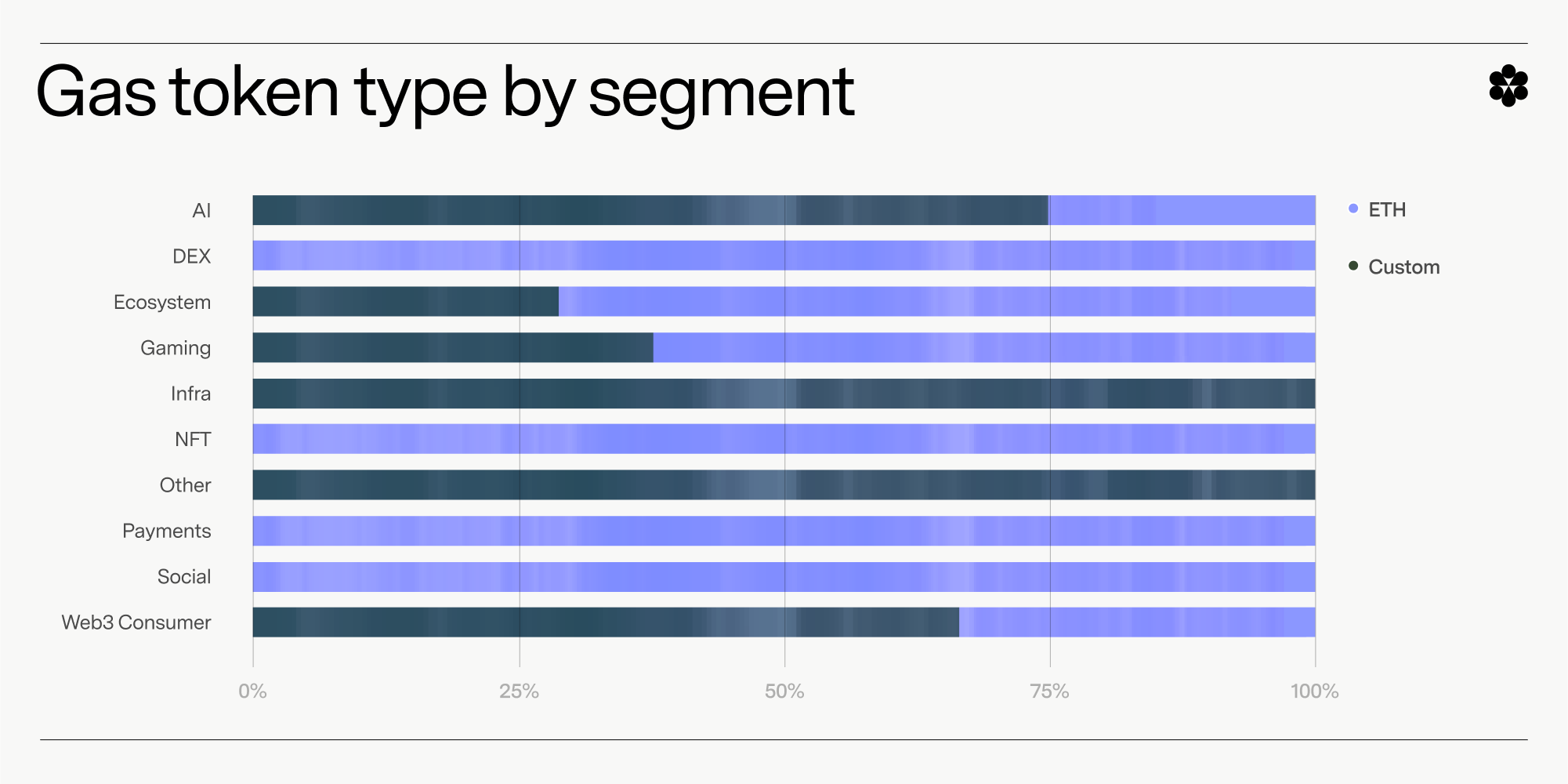
Most rollups use ETH for their gas token, but others are using their own native token – in particular, those using their native token as a rewards mechanism, which is common for web3 consumer apps and infrastructure apps.
Rollup predictions for 2025
More high-performance rollups, led by gaming
As rollups continue to scale Ethereum in accordance with the rollup-centric roadmap, and more projects find success by launching on their own chain, we think more teams will turn to rollups for ultra-high throughput use cases.
The logic is simple: Teams want to build unstoppable apps on a credibly neutral blockchain, and Ethereum is the best option. But getting the throughput necessary for truly complex, hyper-scaled apps on Ethereum is impossible, both economically and in terms of infrastructural resources. Rollups allow those teams to get the throughput they need to build ambitious onchain apps at a feasible cost — as long as they partner with the right infrastructure providers. That thesis led us to launch the Conduit G2 Sequencer last year, and the interest G2 has drawn, along with the evolution of the rollup landscape, has us convinced it remains true.
We predict that many of the most prominent projects scaling Ethereum with rollups in 2025 will be onchain games. Onchain gaming remains one of the most promising, widely discussed sectors of crypto, but running a modern game onchain requires huge amounts of throughput and computing power. Gaming studios like Proof of Play have shown that it can be done though, making huge infrastructural breakthroughs to push past scaling barriers, such as launching a second rollup to provide even more throughput for one onchain game. We expect more builders to follow their lead in 2025.
More protocols and CEXs will launch appchains
Another trend we expect to continue in 2025: Prominent CEXs and protocols running on shared blockchains launching their own appchain rollups. Uniswap kicked this trend off last year when it launched Unichain as part of the Optimism Superchain, and Kraken followed suit soon after with the Ink Chain.
Protocols can realize several benefits from running a dedicated appchain. For one, apps can offer the same level of service with lower fees for users, as they’re no longer competing with other protocols for blockspace. This, along with the customizability apps get from launching their own rollup, allows them to settle transactions faster, which translates to better user experience. Unichain, for example, is building its rollup with 250ms block times to make DEX transactions settle instantaneously, and is also integrating TEEs from Flashbots Rollup-Boost to reduce the number of reverted transactions and protect users from predatory forms of MEV with transparent transaction ordering. Appchain rollups let builders design the perfect chain for their users from the ground up, rather than accept the limitations inherent to Ethereum mainnet, while still getting Ethereum’s security guarantees.
While CEXs don’t deal with the same problems around shared blockspace as onchain protocols, they can still use a dedicated appchain to open up a new line of business in the growing world of DeFi, while still tapping into the same benefits of customization.
There’s also a strong economic case for apps to launch their own chains rather than run as protocols on a shared chain. When a protocol runs on an L1 like Ethereum, its users have to pay gas fees that accrue to that L1. A dedicated rollup doesn’t just allow an app to reduce those fees for users — it also lets the app collect the gas fees it does charge as revenue. So, all else being equal, an onchain app running its own dedicated rollup will make more money than one running on a shared blockchain.
How big is this opportunity? Let’s look at how much Unichain’s protocol on Ethereum makes in trading fees as revenue today, versus how much its users pay in gas fees that accrue to Ethereum.
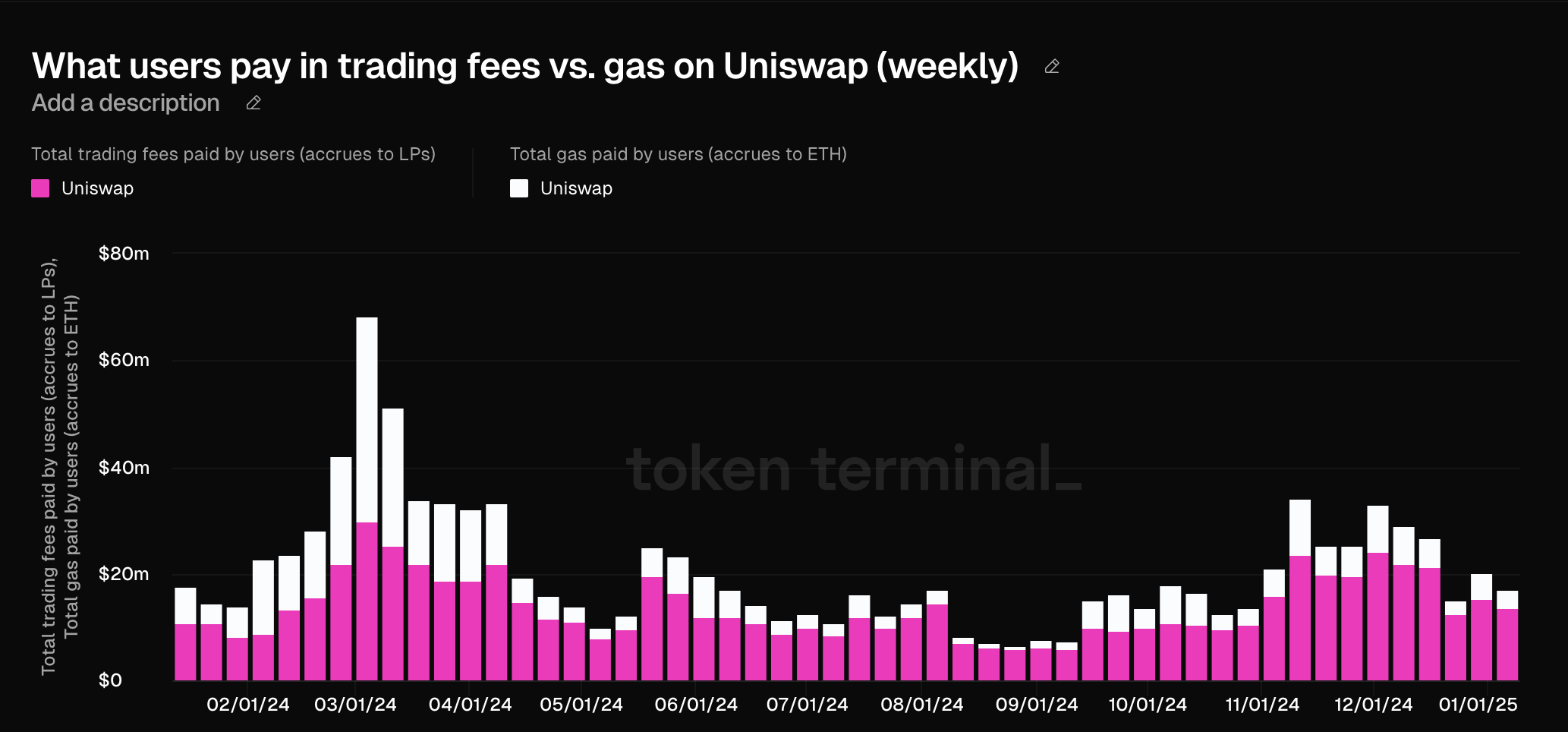
Source: TokenTerminal
Overall, Uniswap’s trading fee revenue on Ethereum over the last year is $1.05 billion, while its users have paid $352.7 million in gas fees. In some months, user gas fees have even eclipsed trading revenue. In essence, Uniswap has paid $352.7 million — roughly one third of its potential revenue — in rent to Ethereum. A rollup would allow Ethereum to collect that money as revenue (though some would have to pay for data availability). Uniswap wouldn’t have to necessarily keep all of that money though. A rollup would give Uniswap the option to lower fees, and it could also pay some of that extra money to users as rewards. As a protocol on a shared blockchain though, none of that is an option.
Interoperability improves as more rollups transition to ZK
We believe that in 2025, many rollups will transition from the optimistic to ZK proving model, and that this will unlock interoperability that makes using the growing network of Ethereum L2s feel like using a single chain.
Today, most rollups are optimistic rollups, meaning they use the fraud proof proving system for confirming transaction validity. Under this model, all transactions are assumed to be optimistic by default, and there’s a seven-day challenge period during which users can challenge transaction validity. While this model is effective for preventing invalid transactions, it does mean that users face a seven-day waiting period for bridging funds off of the rollup.
ZK rollups, on the other hand, are more efficient because they submit a cryptographic proof with each new batch of transactions that confirms immediately whether or not all transactions are valid. That means ZK rollups can offer fast finality, allowing users to bridge funds off of the rollup in as little as one hour rather than seven days.
For this reason, as well as the fact that ZK validity proofs are more secure than the network of incentivized actors optimistic fraud proofs rely on, most of the rollup community has long considered a transition to ZK the end game all optimistic rollups should be driving toward. The problem is that ZK rollups require more specialized technical knowledge to build, and utilize a zkEVM that makes it harder for developers to build apps. Transitioning a whole rollup’s worth of apps to zkEVM compatibility is difficult.
However, that changed in 2024 with Succinct Labs’ introduction of OP-Succinct. OP-Succinct uses a specialized zkEVM that can integrate with existing optimistic rollups using Rust code that most developers are familiar with, making the transition from optimistic to ZK rollup fast and easy. We predict that in 2025, many rollups — especially large ones operating at a scale that allows them to amortize the extra costs of ZK proving across a large user base — will take advantage of this technology to transition to ZK.
A mass transition to ZK rollups and the transition to fast finality will result in huge gains for interoperability. Right now, one of the major drawbacks of the rollup-centric roadmap is that liquidity is fragmented across the many rollups in operation. Users have to bridge funds to each new rollup they want to use, but when they bridge off of an optimistic rollup, they have to wait seven days for the funds to become available — an eternity in crypto time. There are fast bridges and interoperability protocols that speed this process up and use intents to make it easier for users, but these tools function by fronting users their funds on the new chain and getting reimbursed later, after the seven-day waiting period is up — a capital intensive model that makes them expensive to use.
All of that will be a thing of the past when rollups transition to ZK. With one-hour transaction finality, users will be able to bridge easily and cheaply, and interoperability protocols will become much cheaper, which means more users will be able to take advantage of their UX improvements, cutting down on the friction bridging introduces today.
The end result: The network of rollups scaling Ethereum will feel more and more like one big chain, making crypto more accessible both to retail non-natives who don’t have the patience for slow bridging, and to institutional investors who can’t tolerate a seven-day capital lockup.
The future is bullish for rollups
The rollup revolution is just getting started. In the past year alone, we’ve seen major breakthroughs in throughput, interoperability, and developer tooling, each one moving us further along the rollup-centric roadmap. High-performance rollups are enabling new classes of applications, from complex DeFi protocols to fully onchain games that were previously impossible to run onchain.
At Conduit, we’re powering this future. Whether it’s through high-performance sequencers, robust DA solutions, or seamless developer tooling, we’re building the infrastructure that makes rollups not just viable, but inevitable. Ethereum’s rollup-centric roadmap is no longer just a vision – it’s the reality being built today.
Convinced that rollups are the future? Contact us and learn how to launch your own.
End notes:
[1] Data runs through January 24, 2025.
[2] Note: Some Conduit rollups are not tracked by L2Beat yet.

